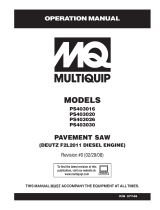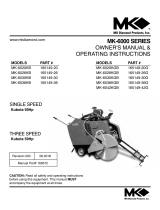
5
SAFETY WARNINGS
WARNING
Failure to comply with the following warnings could
result in serious bodily injury or death!
PERSONAL SAFETY
• Read and understand instructions before operating saw.
• Always wear safety approved hearing, eye, head and
respiratory protection.
• Wear boots with non-slip soles to provide proper footing.
Steel-toed safety boots are recommended.
• Wear rubber work gloves to avoid contact with wet concrete
which can cause serious skin irritation.
• Know how to stop the saw quickly in case of emergency.
• Keep all parts of your body away from blade and other
moving parts. Do not wear loose clothing or jewelry which
can be caught in moving parts. Wear protective hair covering
to contain long hair.
• Use caution when loading and unloading saw.
• Stay alert. Maintain awareness of saw operation. Use
common sense. Do not operate saw when tired or after
consumption of any substance that would impair physical
function or rational judgment.
• Do not over reach. Keep proper footing and balance.
WORK AREA SAFETY
• Never operate the saw in any application or job where you
are not trained or supervised.
• Keep visitors, children and animals out of the work area.
• Observe all safety regulations for the safe handling of fuel.
Gasoline is extremely ammable and its vapors can explode
if ignited. Do not refuel indoors or in poorly ventilated areas.
Handle fuel in safety containers. Shut off the engine and
allow it to cool before refueling. Wipe the saw dry if fuel is
spilled on it. Always move away from the fueling area before
starting the engine. Do not smoke while refueling.
• Do not operate the saw while smoking or near an open ame.
• Do not operate the saw in areas of combustible material or
fumes. Sparks may occur from the saw that could cause a
re or explosion.
• Operate only in well ventilated areas. Engine exhaust contain
carbon monoxide which can cause loss of consciousness and
possible death.
• The mufer and engine become very hot during operation.
Keep all body parts and foreign material away from the
engine while running.
• Avoid dangerous environments. Do not expose saw to rain.
Keep work area well lit and clean.
SAW SAFETY
• Do not leave saw unattended while the engine is running.
• Do not alter the saw. Any alteration or modication is misuse
and may result in a dangerous condition.
• All safety guards must be in place before starting the engine.
• Only operate the saw from behind the machine with both
hands on the handle.
• Do not use damaged equipment, blades, guards or personal
protection equipment. Do not disable safety equipment or kill
switches.
• Do not operate the saw if there is a fuel leak.
• Use extreme caution when maneuvering the saw on ramps
or loading and unloading from trucks or trailers.
• Use only Husqvarna Construction Products replacement
parts. Use of unauthorized parts may create a danger.
• Do not use the saw as vehicle for transporting personnel or
equipment.
• Remove the ignition cable from the spark plug before
performing saw maintenance or changing blades to prevent
accidental engine starting.
• Remove all wrenches from the saw before starting.
• Never stand on the saw.
• When the saw is not in use or transporting, remove the blade
and lower the saw completely. Properly secure the saw to
prevent accidental movement.
BLADE SAFETY
• Examine cutting blades before each use. Do not use any
blades that has cracks, nicks, or aws. Tri-arbor hole should
be undamaged. Use only dry cut, steel centered, tri-arbor
diamond blades made for cutting green concrete.
• Husqvarna Excel Series diamond blades are designed to
only cut green concrete. Cutting any other material may result
in blade failure or a dangerous condition.
• Inspect blade anges for damage, excessive wear and
cleanliness before mounting the blade. The blade should t
snugly on clean, undamaged, tri-arbor shaft.
• Use only Husqvarna Excel Series blades or blades marked
with a maximum operating speed greater than 3200 rpm.
• Never operate the saw without the blade block assembly
securely in place including blade cover, lexan shields and
skid plate installed in working order. A damaged blade block
assembly must be replaced to protect the operator.
• Make sure the blade does not make contact with the ground
or any other surface when maneuvering the saw.
• Avoid getting in direct line with the blade or contacting the
blade while it is rotating.





















